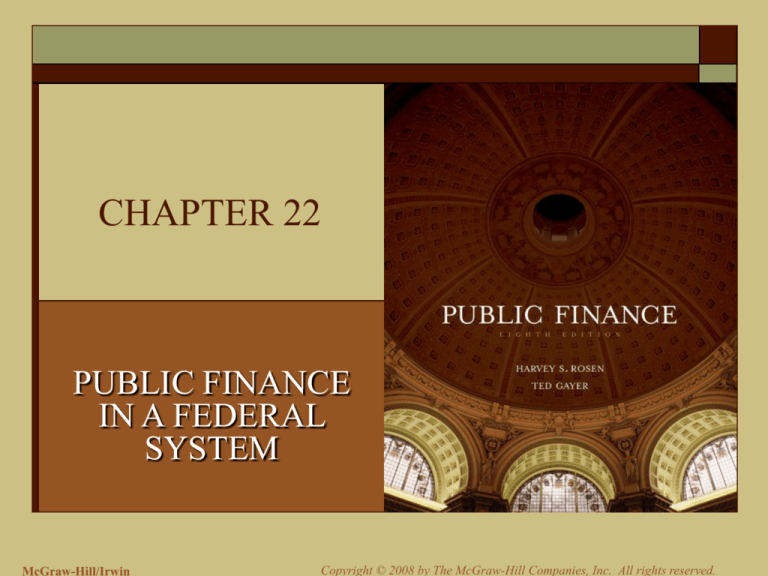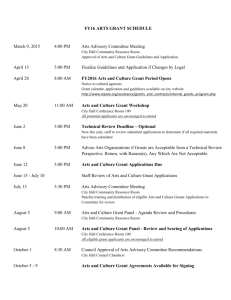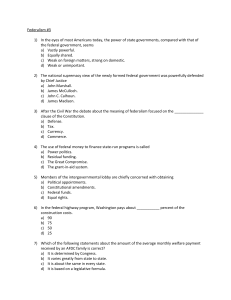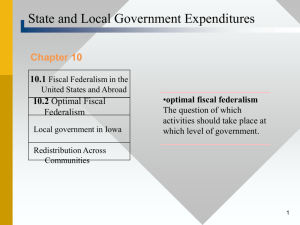
CHAPTER 22
PUBLIC FINANCE
IN A FEDERAL
SYSTEM
McGraw-Hill/Irwin
Copyright © 2008 by The McGraw-Hill Companies, Inc. All rights reserved.
Background
Federal system
Fiscal federalism
Centralization
Centralization ratio =
Central government expenditures
Total government expenditures
22-2
Figure 22.1: Distribution of all US government expenditure by level of
government (selected years)
100%
90%
80%
70%
60%
50%
40%
30%
20%
10%
0%
Local
State
Federal
1900 1910 1920 1930 1950 1960 1971 1980 1990 2000 2002
22-3
Community Formation
Club – voluntary association of people who
band together to finance and share some
benefit
Optimal Club (or community)
22-4
The Tiebout Model
Voting with your feet
Tiebout’s assumptions
Government activities generate no externalities
Individuals are completely mobile
People have perfect information with respect to each community’s
public services and taxes
There are enough different communities so that each individual can
find one with public services meeting her demands
The cost per unit of public services is constant so that if the quantity
of public services doubles, the total cost also doubles
Public services are financed by a proportional property tax
Communities can enact exclusionary zoning laws—statutes that
prohibit certain uses of land
22-5
Tiebout and the Real World
Critique of Tiebout
Empirical tests
22-6
Optimal Federalism
Macroeconomic functions
Microeconomic functions
22-7
Disadvantages of a Decentralized System
Efficiency issues
Externalities
local public good
Scale economies in provision of public goods
Inefficient tax systems
Scale economies in tax collection
Equity issues
22-8
Advantages of a Decentralized System
Tailoring outputs to local taxes
Fostering intergovernmental competition
Experimentation and information in locally
provided goods and services
22-9
Implications
Purely decentralized systems cannot maximize social
welfare
Dealing with community activities that create
spillover effects that are not national in scope
Combine communities under a single regional
government
Pigouvian taxes and subsidies
Division of responsibility in public good provision
Distributional goals and mobility
22-10
Public Education in a Federal System
Local control of schools
Financing education through property taxation
Federal role in education
22-11
Property Tax
How the property tax
works
Residential Property Tax Rates
(selected cities)
Effective Tax
Rate*
Assessed value
City
Assessment ratio
Newark
2.96%
Detroit
1.82
Atlanta
1.79
New Orleans
1.75
Chicago
1.69
Charlotte
1.13
New York
1.12
Los Angeles
1.08
*Figures are for 2003.
Source: US Bureau of the Census
[2006, p. 301]
22-12
Rent per acre
of land
Incidence and Efficiency Effects – The Traditional
View - Tax on Land
PsL = PP00LL
SL
Price received by
landowners falls
by amount of the
tax
PnL
DL
DL’
Acres of land
22-13
Incidence and Efficiency Effects – The Traditional
View - Tax on Land
Tax capitalized into price of land
Land not fixed in supply
22-14
Price per
structure
Incidence and Efficiency Effects – The Traditional View Tax on Structures
Price paid by
tenants increases
by full amount of
the tax
PgB
SB
BB
PnB = PP
00
PnL
DB
DB’
B1
B0
Number of structures
22-15
per year
Summary and Implications of the
Traditional View
Progressivity
Land tax
Structures tax
Empirical evidence
Measuring income
22-16
The New View: Property Tax as a Capital Tax
Partial equilibrium versus general equilibrium
General Tax effect
Excise Tax effects
Long-run effects
22-17
Property Tax as a User Fee
The notion of the incidence of the property
tax is meaningless
The property tax creates no excess burden
Federal income tax subsidizes consumption of
local public services for individuals who
itemize
Oates [1969]
22-18
Reconciling the Three Views
New view: Eliminating all property taxes and
replacing them with a national sales tax
Traditional view: Lowering property tax rate
and making up revenue from local sales tax
User fee view: Taxes and benefits jointly
changed and people are sufficiently mobile
22-19
Why Do People Hate the Property Tax So Much?
Property tax levied on estimated value
Property tax highly visible
Property tax perceived as being regressive
Circuit breakers
Property tax easier to attack
22-20
Ideas for Improving the Property Tax
Improve assessment procedures
Personal net worth tax
22-21
Intergovernmental Grants
Relation of federal grants-in-aid to federal and state-local
expenditures (selected fiscal years)
Year
1960
1970
1980
1990
2000
2004
Total Grants
(billions of
2004 dollars)*
$21
76
146
149
270
348
Grants as a
Percent of
Total Federal
Outlays
4.61%
9.6%
12.3%
8.9%
13.3%
14.6%
Grants as a
Percent of State
and Local
Expenditures
10.0%
17.1%
21.9%
15.2%
19.5%
21.9%
*Amounts are converted to 2004 dollars using the GDP deflator.
Source: Computed from Economic Report of the President [2006, pp. 375, 379]
22-22
Why Have Intergovernmental Grants Grown
So Much?
Mismatch theory
22-23
Consumption (c)
per year
Conditional (Categorical) Grants
Matching Grants
A
c2
c1
E2
E1
G1 G2
B
R
Units of public good (G) per year
22-24
Consumption (c)
per year
Conditional (Categorical) Grants
Matching Closed-Ended Grants
A
c3
c1
D
E1
E3
G1 G3
B
R
Units of public good (G) per year
22-25
Consumption (c)
per year
Conditional (Categorical) Grants
Nonmatching Grants
J
A
c4
c1
H
E4
E1
G1 G2
B
R
Units of public good (G) per year
22-26
Unconditional Grants
Revenue sharing
Measuring Need
Tax effort
22-27
The Flypaper Effect
Whose indifference curves?
Median voter theorem
Flypaper effect
22-28
Intergovernmental Grants for Education
Serrano v Priest [1971]
Foundation aid
District power equalization grants
Issues
Educational outcomes
Impact of centralized financing on voters’ support
for public education
22-29






